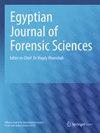从Ajnala井附近的一处遗址挖掘出的碎片状颅骨遗骸的鉴定:法医人类学案例报告
IF 1.3
Q3 MEDICINE, LEGAL
引用次数: 0
摘要
人类经历了几次意想不到的灾难、滔天罪行和野蛮行径,导致大量身份不明的遗骨有待鉴定并送还给其亲属。2014年初,阿贾那拉(印度)发生了一起1857年殖民统治者大规模杀害282名印度裔士兵的事件。2014年晚些时候,在Ajnala集体墓地附近找到了属于两个人的受损头骨碎片。在目前的研究中,对检索到的头骨元素进行了法医人类学检查,以评估它们的亲缘关系是否与被杀害的Ajnala印度兵或在此之前或之后埋葬的死者相似。对这些遗骸的形态学和分子分析证实,它们与1857年在阿杰那拉被杀的印度兵有关。对颅骨碎片进行的法医人类学和分子检查发现,这些遗骸属于在Ajnala事件中被杀害的人。多学科方法应用于鉴定严重受损,破碎和混合的人类遗骸有助于他们的推定身份。本文章由计算机程序翻译,如有差异,请以英文原文为准。
Identification of fragmented cranial remains excavated from a site adjoining Ajnala well: a forensic anthropological case report
Abstract Background Mankind have suffered several unexpected disasters, heinous crimes, and brutalities, resulting into large number of unknown skeletal remains to be identified and repatriated to their relatives. Case presentation One such incident of mass killing of 282 Indian-origin soldiers by the colonial rulers in 1857 was reported from Ajnala (India) in early 2014. The damaged cranial fragments belonging to two individuals were retrieved from the vicinity of Ajnala mass-burial site later in 2014. In present study, the retrieved cranial elements were examined forensic anthropologically to assess whether their affinity is akin to the slain Ajnala sepoys or to the deceased who were buried prior to or later than it. The morphological and molecular analyses of these remains affirmed their affiliation to the mutiny sepoys of 1857 killed at Ajnala. Conclusions The forensic anthropological and molecular examinations of cranial fragments found that these remains belonged to the individuals killed in the Ajnala incident. The multidisciplinary approach applied for identification of the badly damaged, fragmented, and commingled human remains helped in their presumptive identification.
求助全文
通过发布文献求助,成功后即可免费获取论文全文。
去求助
来源期刊

Egyptian journal of forensic sciences
MEDICINE, LEGAL-
CiteScore
2.00
自引率
0.00%
发文量
51
审稿时长
17 weeks
期刊介绍:
Egyptian Journal of Forensic Sciences, the official publication of The International Association of Law and Forensic Sciences (IALFS), is an open access journal that publishes articles in the forensic sciences, pathology and clinical forensic medicine and its related specialities. The journal carries classic reviews, case studies, original research, hypotheses and learning points, offering critical analysis and scientific appraisal.
 求助内容:
求助内容: 应助结果提醒方式:
应助结果提醒方式:


